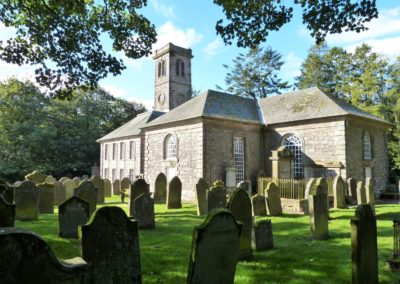
Durisdeer Parish Church
Denomination: Church of Scotland
Address: , Durisdeer , DG3 5BJ
Local Authority: Dumfries & Galloway
Listing: A
Church Overview
Unspoilt, peaceful, Georgian country parish church, mostly dating from 1719-20 but built on the foundation of a much older church.
Believed to have been designed by Scottish architect James Smith, this handsome X-plan church was rebuilt to the orders of the Duke of Queensberry, who ordered an additional wing at the west end, topped by a square belfry tower, containing the retiring rooms for the ducal family. It is believed that the stones used to build the new church were taken from the recently demolished Durisdeer Castle.
The interior, renovated 1784-5 and re-arranged circa 1870, has a typically presbyterian layout with central pulpit and three galleries. Many of the box pews have a central communion table. The ducal apartments were later used as a parish school on the orders of the Duke. This wing was renovated in 1968 for the use of the congregation.
The adjoining Queensberry Aisle is taller and more sophisticated and is all that remains from the earlier church. It contains the real jewel of the church: the most amazing monument for the Queensberry burial vault, a baroque mural monument and free-standing baldacchino carved in 1695 by John van Nost to the design of James Smith. A riot of swagged fabric, garlands of flowers, urns, barley-sugar columns, cherubs, skulls and pediments, all in gleaming white marble.
The churchyard contains some fine 17th-19th century stone monuments, many with classical ornament, including the martyr’s monument to Covenanter Daniel MacMichael and the 1685 monument to the children of William Lukup, Master of Works at nearby Drumlanrig. Visitors will fine history guide notes and a graveyard index in the church
Durisdeer Parish Church is a Destination Hub on our St Ninian Pilgrim Journey.
Disclaimer
The information about churches in Scotland’s Churches Scheme has been provided by the congregations or taken from the Historic Scotland list and published sources, in particular, the Buildings of Scotland volumes and the RIAS Illustrated Architectural Guides. To contact this specific church please complete the Contact this Church form above. The information is not authoritative; please contact Scotland’s Churches Trust to let us know of any errors or omissions.





